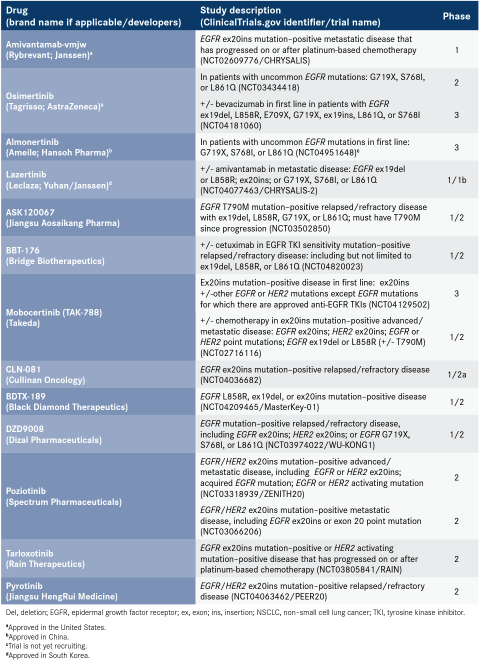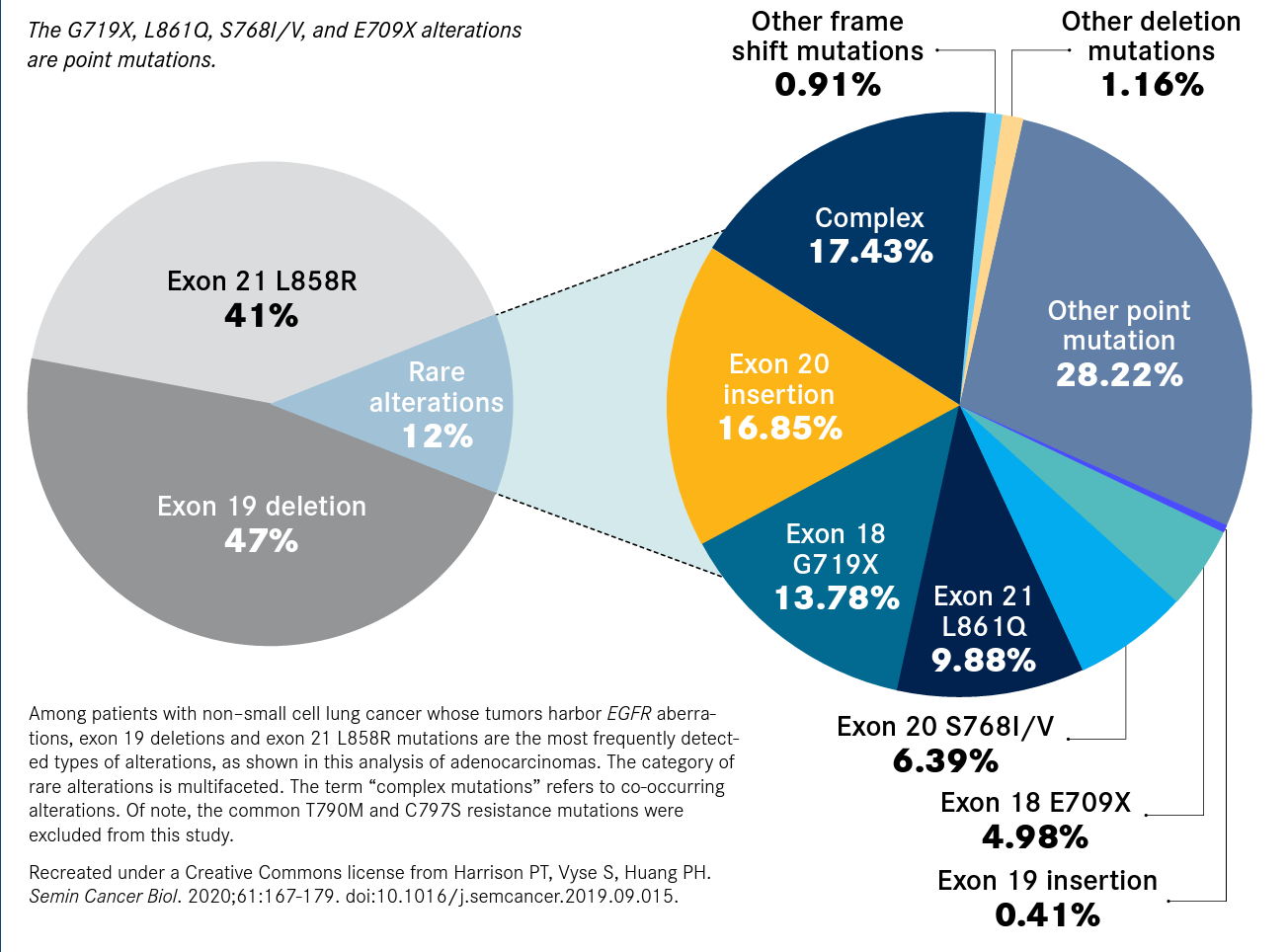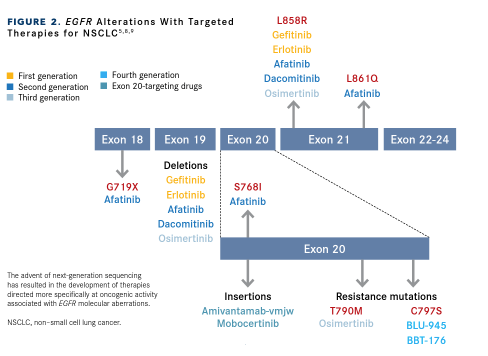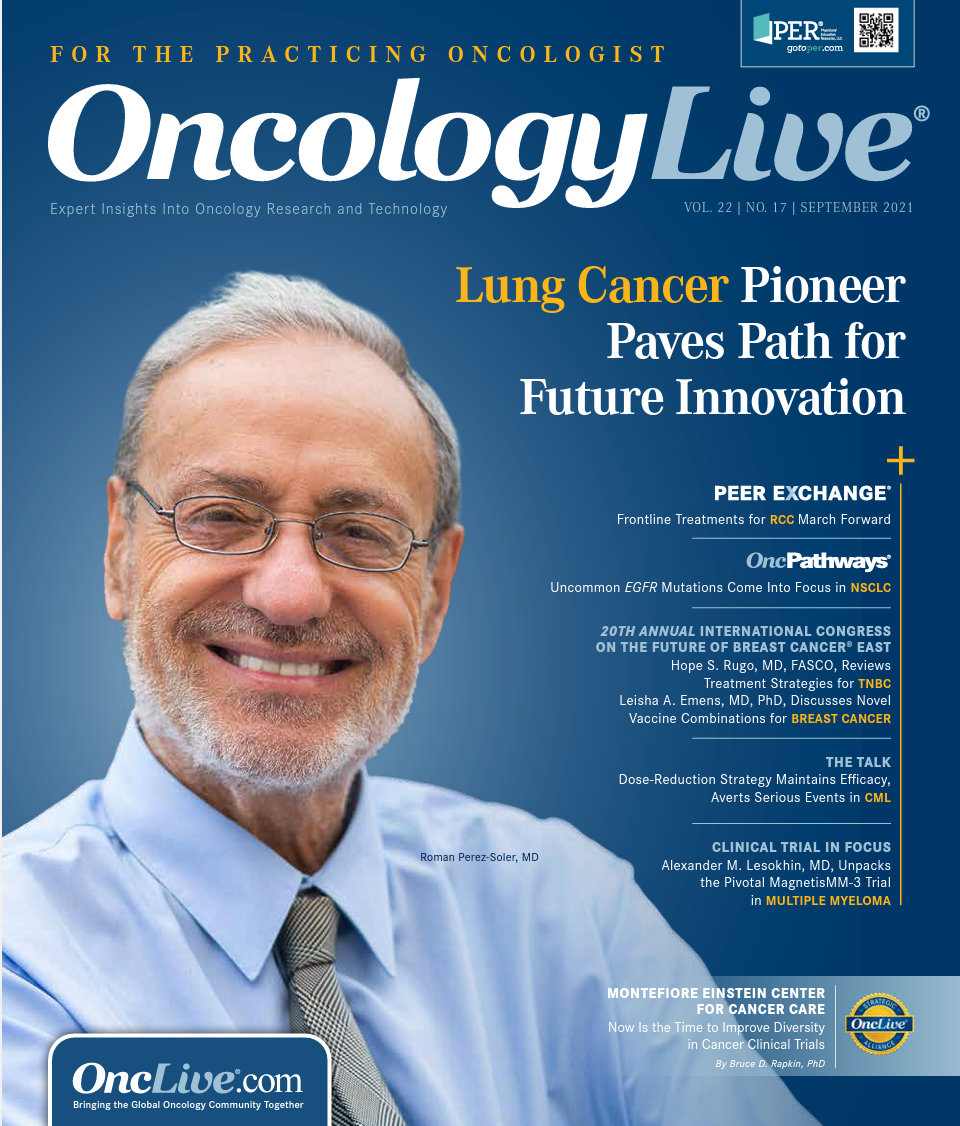Publication
Article
Oncology Live®
Uncommon EGFR Mutations Come Into Focus With Novel NSCLC Therapies
Author(s):
The understanding of EGFR signaling in non–small cell lung cancer continues to evolve, helping to spark the development of novel therapies for new patient populations with uncommon alterations.
The understanding of EGFR signaling in non–small cell lung cancer (NSCLC) continues to evolve, helping to spark the development of novel therapies for new patient populations with uncommon alterations.
In May, the FDA granted an accelerated approval to amivantamab-vmjw (Rybrevant) for patients with locally advanced or metastatic NSCLC harboring EGFR exon 20 insertion mutations with disease progression on or after platinum-based chemotherapy. The bispecific antibody, which targets EGF and MET receptors, is the first therapy approved for this subset of patients with NSCLC.1
Amivantamab is among a growing number of drugs with activity against EGFR exon 20 insertion–mutant disease undergoing clinical testing (Table).
Table. Select Clinical Trials Targeting Uncommon EGFR Mutations in NSCLC

These include mobocertinib (TAK-788), which the FDA is evaluating under its priority review program for patients with metastatic exon 20 insertion mutation–positive NSCLC who have received platinum-based chemotherapy. The agency is scheduled to decide on a new drug application (NDA) by October 26, 2021, according to Takeda Pharmaceutical Company Limited, the company developing the therapy.2
The development of therapies aimed specifically at exon 20 alterations is the latest step in personalizing EGFR-directed therapies in the NSCLC field. Until recently, EGFR inhibitors were available only for patients with the so-called classical EGFR mutations (exon 19 deletions and the L858R substitution in exon 21) and the secondary resistance mutation T790M.3-5
Growing use of next-generation sequencing (NGS) has increased recognition of less common EGFR mutations in NSCLC.3-5 In particular, exon 20 insertion mutations have become increasingly therapeutically relevant, with evidence that they confer poorer patient prognosis and insensitivity to first- and second-generation EGFR inhibitors.3,4,6
In the EGFR mutational landscape in NSCLC, classical aberrations account for about 88% of the primary EGFR alterations found in adenocarcinomas, whereas rare mutations together make up 12% (Figure 15). Overall, activating EGFR mutations are found in the tumors of 10% to 20% of Caucasian patients and at least 50% of Asian patients with NSCLC,5 including exon 20 insertion mutations in approximately 2% to 3% of cases.6
Figure 1. The EGFR Mutational Landscape in Non–Small Cell Lung Cancer5

Refining First-Generation Inhibitors
Despite their introduction into clinical practice in the United States nearly 20 years ago, EGFR inhibitors began to truly transform patient outcomes only with the identification of EGFR activating mutations as biomarkers of response.3 Investigators initially believed that high EGFR expression as opposed to EGFR mutations was needed for efficacy of the inhibitors.7
The first generation of EGFR tyrosine kinase inhibitors (TKIs), such as gefitinib (Iressa) and erlotinib (Tarceva), have a complicated history. The recognition of EGFR as a driver of NSCLC prompted their development, but their initial approvals in the early 2000s predated a complete understanding that response to EGFR TKIs was predicted by alterations in the EGFR gene. As a result, both drugs received broad approval to treat patients who had progressed following chemotherapy.7-9
As confirmatory trials failed to translate improved response rates into prolonged progression-free survival (PFS) or overall survival (OS), these drugs quickly fell out of favor, and gefitinib was withdrawn from the market. Despite the rocky start, the approvals of gefitinib and erlotinib paved the way for the identification of activating mutations in the EGFR kinase domain in patients with NSCLC, which predicted response to these agents.7,9,10
Clinical development of the first- generation adenosine triphosphate (ATP)–competitive, reversible EGFR TKIs was refocused on patients with EGFR-mutant NSCLC, and these 2 drugs ultimately reemerged as highly effective frontline treatment options in this patient population.9
Despite their clear superiority over chemo-therapy, first-generation EGFR TKIs are eventually associated with disease progression in almost all patients, typically after approximately 1 year of therapy. As a result, a second generation of more potent, irreversible EGFR TKIs was developed.8,9
The FDA has approved afatinib (Gilotrif) and dacomitinib (Vizimpro) for the frontline treatment of EGFR-mutant NSCLC. However, their clinical utility is still impeded by the frequent development of resistance, and they are associated with significant dose-limit-ing toxicities because they nonspecifically target the wild-type EGFR protein and additional members of the HER family.5,8
Tackling Resistance
As the mechanisms underlying resistance to EGFR inhibitors were explored, one particular mutation emerged as a key target for novel drug development. EGFR T790M, in which a bulkier methionine is substituted for threonine at amino acid 790, is known as the gatekeeper mutation because the wild-type threonine controls access to a hydrophobic pocket within the active site of EGFR to which the first-generation drugs bind.11
The T790M mutation, which is the primary mechanism of resistance to the first- and second-generation EGFR TKIs, is identified as a somatic alteration in more than half of patients previously treated with a TKI but few treatment-naïve patients.11,12
The third generation of EGFR TKIs are designed to specifically target this mutation to help overcome resistance. In 2015, The third generation of EGFR TKIs are designed to specifically target this mutation to help overcome resistance. In 2015, osimertinib (Tagrisso) became the first and thus far only third-generation EGFR TKI to receive FDA approval, with an indication for metastatic T790M-positive NSCLC in the relapsed/refractory setting.8,13,14
The first- and second-generation of EGFR TKIs are approved to treat tumors with the most common activating mutations in EGFR, exon 19 deletions and exon 21 L858R mutations, which are often referred to as classical or EGFR TKI–sensitizing mutations. In addition to the T790M resistance mutation, osimertinib also targets these activating mutations.13
Subsequently, investigators demonstrated superior efficacy and improved toxicity for osimertinib compared with erlotinib and gefitinib in patients with classical mutations, most likely because of osimertinib’s minimal inhibition of wild-type EGFR.15 These findings led to osimertinib’s approval in the frontline setting in 2018, where it has supplanted the other EGFR TKIs as the preferred treatment option for patients with EGFR-mutant NSCLC.14,16 Most recently, osimertinib was approved for the adjuvant treatment of patients with early-stage EGFR-mutant (L858R/exon 19 deletion) NSCLC after tumor resection.14
A swathe of other third-generation EGFR inhibitors are in clinical development, with the goal of improving upon the efficacy and safety of osimertinib,8 and several have been approved for use outside the United States. Lazertinib (Leclaza) is a novel third-generation TKI that targets the classical mutations in addition to the T790M mutation and spares wild-type EGFR. It was developed by the Seoul-based pharmaceutical company Yuhan, with global rights acquired by Janssen Biotech, Inc.17
Lazertinib was recently approved in South Korea for the treatment of patients with T790M mutation–positive locally advanced or metastatic NSCLC who have previously been treated with an EGFR TKI, based on data from parts A to C of the phase 1/2 LASER201 trial (NCT03046992), in which the overall response rate (ORR) was 57.9%, the median PFS was 11.0 months, and median duration of response (DOR) was 13.8 months. Part D of this trial, listed under a different ClinicalTrials.gov identifier (NCT04075396) is evaluating lazertinib outside of Korea.17,18
Furmonertinib (Alflutinib) and almonertinib (Ameile) are also third-generation EGFR TKIs that are approved in China for the treatment of T790M mutation–positive NSCLC in the second-line setting.19,20 Phase 3 clinical trials of all 3 drugs are ongoing in patients with exon 20 insertion mutations. Meanwhile, a fourth generation of EGFR TKIs is in development to tackle resistance to third-generation agents such as osimertinib, which typically emerges after 1 to 2 years of treatment.8 The most common mechanism of such resistance is the EGFR C797S mutation, which affects a cysteine at the edge of the ATP binding pocket to which these drugs covalently bind.8,21
Fourth-generation EGFR TKIs are triple inhibitors, designed to target the classical activating mutations as well as the T790M and C797S resistance mutations.8 BLU-945 and BBT-176 have recently entered phase 1/2 clinical trials (NCT04862780, NCT04820023).
Uncommon Mutations
Much less is known about uncommon EGFR mutations; however, with the increasing availability of NGS, they are more readily identifiable, and there is a growing body of information about the clinicopathologic characteristics and treatment response associated with these mutations.4,5,22 The development of molecularly targeted therapies has become increasingly specific (Figure 25,8,9).
Figure 2. EGFR Alterations With Targeted Therapies for NSCLC5,8,9

Among them, the most prevalent point mutations are G719X (exon 18), S768I (exon 20), and L861Q (exon 21).5,23 In 2018, the FDA expanded the afatinib approval to include NSCLC displaying these point mutations, based on data from a subset of 32 patients with metastatic NSCLC bearing these mutations across 3 pivotal clinical trials of afatinib, LUX-Lung 2 (NCT00525148), LUX-Lung 3 (NCT00949650), and LUX-Lung 6 (NCT01121393), in which responses lasting 12 months or more were observed in 52% of the 21 responders.24,25 Osimertinib also recently demonstrated efficacy in patients with NSCLC with tumors harboring these and other uncommon mutations in a phase 2 study (NCT03424759).26
The pan-HER inhibitor neratinib (Nerlynx) had previously demonstrated a dismal 3% ORR in patients with EGFR-mutant NSCLC in a phase 2 study (NCT00266877). However, the few patients who responded had exon 18 mutations, another type of uncommon EGFR mutation. According to an interim analysis of the phase 2 SUMMIT basket trial (NCT01953926), neratinib produced 4 confirmed PRs among 10 efficacy-evaluable patients with previously treated, exon 18-mutant NSCLC.3,27
The largest group of uncommon mutations are insertion mutations in exon 20.5 Similarly to the classical EGFR mutations, exon 20 insertions are more common in women, nonsmokers, and those with adenocarcinoma histology.3,6 Patients with exon 20 insertions have a worse prognosis compared with those with other types of EGFR mutations, with outcomes similar to patients with wild-type EGFR.6
Although exon 20 insertions are located within the kinase domain, they do not affect the ATP-binding pocket, which plays a critical role in the regulation of enzyme activity by undergoing a conformational change. Because exon 20 insertions affect the EGFR protein differently compared with classical mutations, most are insensitive to the first- and second-generation EGFR TKIs and chemotherapy remains standard of care.
The jury is still out on whether third-generation TKIs are effective in patients with exon 20 insertion mutations, with recent clinical trial data suggesting that osimertinib may have significant activity.28
Targeting Exon 20 Insertion Mutations
Amivantamab
Given the poor prognosis of patients with exon 20 insertion mutations and the lack of effective treatment options, there has been considerable investment in novel drug development. The FDA approved amivantamab for this patient population based on findings from the phase 1 multicohort CHRYSALIS trial (NCT02609776).
In 81 patients previously treated with platinum-based chemotherapy, the ORR with amivantamab monotherapy was 40% (95% CI, 29%-51%), including 3 complete responses. The median DOR was 11.1 months (95% CI, 6.9-not estimable), and 63% of patients had a response lasting 6 months or more.29
In the safety population of 129 patients, adverse effects (AEs) were mostly of grade 1 or 2 severity. The most common all-grade AEs included rash (84%), infusion-related reactions (64%), paronychia (50%), and muskuloskeletal pain (47%). The grade 3/4 incidence of these AEs was 3.9%, 3.1%, 3.1%, and 0%, respectively.29
Amivantamab, which is administered intravenously, also has shown promise in other EGFR-mutant populations in combination with lazertinib. Results from a combination arm of the CHRYSALIS trial were recently presented at the 2021 American Society of Clinical Oncology (ASCO) Annual Meeting for an expansion cohort of patients with exon 19 deletions or L858R mutations who had relapsed after osimertinib therapy.
Among 45 patients treated with the combination, the ORR was 36% (95% CI, 22%-51%) at a median follow-up of 11.0 months (range, 1.0-15.0). The median DOR was 9.6 months (95% CI, 5.3-not reached), and the median PFS was 4.9 months (95% CI, 3.7-9.5). High combined protein expression of EGFR and MET, as evaluated by immunohistochemistry, was identified as a potential biomarker of response to the combination.30
The amivantamab-lazertinib combination is being explored in several clinical trials involving classical and/or uncommon EGFR mutations.
In the phase 3 MARIPOSA study (NCT04487080), investigators are seeking to randomize 1000 patients to lazertinib plus either amivantamab or placebo versus osimertinib plus placebo as first-line therapy for patients with locally advanced or metastatic NSCLC with exon 19 deletions or L858R substitutions. The phase 1/1b CHRYSALIS-2 study (NCT04077463) is testing the amivantamab-lazertinib combination in several cohorts, including one for previously treated patients with exon 20 insertions and one for patients with other uncommon EGFR alterations such as S768I, L861Q, and G719X who have not yet been treated or have received a first- or second-generation EGFR TKI as their last therapy.31
Janssen Research & Development, LLC, which helped bring amivantamab to the US market, is sponsoring the studies.
Mobocertinib
In terms of TKIs, mobocertinib is the most advanced drug in development that specifically targets exon 20 insertion mutations, and it is hot on the heels of amivantamab. The NDA for the agent, which is orally administered, is based primarily on findings from a phase 1/2 trial (NCT02716116) for patients with exon 20 insertion mutations treated with mobocertinib monotherapy at 160 mg once daily.2
Findings from the study per independent review committee (IRC) and investigator assessment were presented at 2021 ASCO for 114 patients previously treated with platinum-based chemotherapy in dose-escalation, dose-expansion, and dose-extension cohorts.
Among these patients, mobocertinib demonstrated an ORR of 28% (95% CI, 20%-37%) with a median DOR of 17.5 months (95% CI, 7.4-20.3) by IRC and 35% (95% CI, 26%-45%) with a median DOR of 11.2 months (95% CI, 5.6-not estimable) per investigator review. All responses were partial under both assessments. The median PFS was 7.3 months (95% CI, 5.5-9.2), and the median OS was 24.0 months (95% CI, 14.6-28.8), both by IRC assessment.31,32
Poziotinib
Analogous insertion mutations also are found within exon 20 of the HER2 protein in NSCLC,3 and the FDA has granted poziotinib, a dual EGFR/HER2 inhibitor, a fast track designation for patients with HER2 exon 20 mutations, according to Spectrum Pharmaceuticals, which is developing the drug.33
Investigators are exploring poziotinib in the multicohort phase 2 ZENITH20 trial (NCT03318939) in patients with locally advanced or metastatic NSCLC with EGFR or HER2 exon 20 mutations.34
Results from cohort 1 for 115 previously treated patients with EGFR exon 20 insertion mutations in the intent-to-treat population demonstrated an ORR of 14.8% (95% CI, 8.9%22.6%), with a median DOR of 7.4 months (95% CI, 3.7-9.7). Among 88 evaluable patients, the ORR was 19.3% (95% CI, 11.7%-29.1%), with the same median DOR. However, 65% of patients required dose reductions; grade 3 and higher treatment- related AEs included rash, diarrhea, stomatitis, and paronychia.34,35
In 79 treatment-naïve patients (cohort 3), the ORR was 27.8% (95% CI, 18.4%-39.1%), with a median DOR of 6.5 months. More than 90% of patients experienced a reduction in tumor burden. To reduce toxicity, cohort 5 of this study is exploring different doses and dosing schedules, and preliminary data from 40 patients suggest that the rates of AEs and dose interruptions may be lower with twice-daily dosing.35,36
References
- FDA approves first targeted therapy for subset of non-small cell lung cancer. News release. FDA. May 21, 2021. Accessed August 18, 2021. https://bit.ly/3y0GXJZ
- Takeda announces U.S. FDA grants priority review for new drug application for mobocertinib (TAK-788) as a treatment for EGFR exon20 insertion+ metastatic non-small cell lung cancer. News release. Takeda Pharmaceutical Company Limited. April 27, 2021. Accessed August 18, 2021. https://bit.ly/3k818AH
- Vyse S, Huang PH. Targeting EGFR exon 20 insertion mutations in non-small cell lung cancer. Signal Transduct Target Ther. 2019;4:5. doi:10.1038/s41392-019-0038-9
- Burnett H, Emich H, Carroll C, Stapleton N, Mahadevia P, Li T. Epidemiological and clinical burden of EGFR exon 20 insertion in advanced non-small cell lung cancer: a systematic literature review. PLoS One. 2021;16(3):e0247620. doi:10.1371/journal.pone.0247620
- Harrison PT, Vyse S, Huang PH. Rare epidermal growth factor receptor (EGFR) mutations in non-small cell lung cancer. Semin Cancer Biol. 2020;61:167-179. doi:10.1016/j.semcancer.2019.09.015
- Remon J, Hendriks LEL, Cardona AF, Besse B. EGFR exon 20 insertions in advanced non-small cell lung cancer: a new history begins. Cancer Treat Rev. 2020;90:102105. doi:10.1016/j.ctrv.2020.102105
- Karachaliou N, Fernandez-Bruno M, Bracht JWP, Rosell R. EGFR first- and second-generation TKIs—there is still place for them in EGFR-mutant NSCLC patients. Transl Cancer Res. 2019;8(suppl 1):S23-S47. doi:10.21037/tcr.2018.10.06
- Du X, Yang B, An Q, Assaraf YG, Cao X, Xia J. Acquired resistance to third-generation EGFR-TKIs and emerging next-generation EGFR inhibitors. The Innovation. 2021;2(2):100103. doi:10.1016/j.xinn.2021.100103
- Khaddour K, Jonna S, Deneka A, et al. Targeting the epidermal growth factor receptor in EGFR-mutated lung cancer: current and emerging therapies. Cancers (Basel). 2021;13(13):3164. doi:10.3390/cancers13133164
- Kazandjian D, Blumenthal GM, Yuan W, He K, Keegan P, Pazdur R. FDA approval of gefitinib for the treatment of patients with metastatic EGFR mutation-positive non-small cell lung cancer. Clin Cancer Res. 2016;22(6):1307-1312. doi:10.1158/1078-0432.CCR-15-2266
- Ko K, Jeong CW, Kwak C, Kim HH, Ku JH. Significance of Ki-67 in non-muscle invasive bladder cancer patients: a systematic review and meta-analysis. Oncotarget. 2017;8(59):100614-100630. doi:10.18632/oncotarget.21899
- Ye X, Zhu ZZ, Zhong L, et al. High T790M detection rate in TKI-naive NSCLC with EGFR sensitive mutation: truth or artifact? J Thorac Oncol. 2013;8(9):1118-1120. doi:10.1097/JTO.0b013e31829f691f
- Greig SL. Osimertinib: first global approval. Drugs. 2016;76(2):263-273. doi:10.1007/s40265-015-0533-4
- Tagrisso (osimertinib) FDA approval history. Drugs.com. Updated December 22, 2020. Accessed July 13, 2021. https://www.drugs.com/history/tagrisso.html
- Soria J-C, Ohe Y, Vansteenkiste J, et al; FLAURA Investigators. Osimertinib in untreated EGFR-mutated advanced non-small-cell lung cancer. N Engl J Med. 2018;378(2):113-125. doi:10.1056/NEJMoa1713137
- NCCN. Clinical Practice Guidelines in Oncology. Non-small cell lung cancer, version 5.2021. Accessed July 13, 2021. https://www.nccn.org/professionals/physician_gls/pdf/nscl.pdf
- Dhillon S. Lazertinib: first approval. Drugs. 2021;81(9):1107-1113. doi:10.1007/s40265-021-01533-x
- Jeong-yeo L. Yuhan’s lung cancer treatment lazertinib wins approval. The Korea Herald. January 18, 2021. Accessed July 13, 2021. http://www.koreaherald.com/view.php?ud=20210118001003
- Allist’s third generation EGFR-TKI receives marketing approval for lung cancer in China. Lily Asia Ventures blog. March 3, 2021. Accessed July 12, 2021. http://www.lillyasiaventures.com/blog/allist-s-third-generation-egfr-tki-receives-marketing-approval-for-lung
- Hansoh Pharma’s Ameile (almonertinib) receives marketing authorization in China for second-line treatment for patients with EGFR T790M-mutation non-small cell lung cancer. News release. Hansoh Pharmaceutical Group Company Limited. March 19, 2020. Accessed July 12, 2021. https://www.prnewswire.com/news-releases/hansoh-pharmas-ameile-almonertinib-receives-marketing-authorization-in-china-for-second-line-treatment-for-patients-with-egfr-t790m-mutation-non-small-cell-lung-cancer-301026745.html
- Ayati A, Moghimi S, Salarinejad S, Safavi M, Pouramiri B, Foroumadi A. A review on progression of epidermal growth factor receptor (EGFR) inhibitors as an efficient approach in cancer targeted therapy. Bioorg Chem. 2020;99:103811. doi:10.1016/j.bioorg.2020.103811
- About uncommon EGFR mutations. Boehringer Ingelheim Pharmaceuticals. Accessed July 13, 2021. https://www.gilotrifhcp.com/uncommon-egfr-database/about
- Zhang T, Wan B, Zhao Y, et al. Treatment of uncommon EGFR mutations in non-small cell lung cancer: new evidence and treatment. Transl Lung Cancer Res. 2019;8(3):302-316. doi:10.21037/tlcr.2019.04.12
- Gilotrif FDA approval history. Drugs.com. Accessed July 13, 2021. https://www.drugs.com/history/gilotrif.html
- FDA broadens afatinib indication to previously untreated, metastatic NSCLC with other non-resistant EGFR mutations. FDA. Updated January 16, 2018. Accessed July 14, 2021. https://www.fda.gov/drugs/resources-information-approved-drugs/fda-broadens-afatinib-indication-previously-untreated-metastatic-nsclc-other-non-resistant-egfr
- Cho JH, Lim SH, An HJ, et al. Osimertinib for patients with non-small-cell lung cancer harboring uncommon EGFR mutations: a multicenter, open-label, phase II trial (KCSG-LU15-09). J Clin Oncol. 2020;38(5):488-495. doi:10.1200/JCO.19.00931
- Puma Biotechnology announces interim results from the phase II SUMMIT trial of neratinib for EGFR exon 18 mutated, metastatic non-small cell lung cancer. News release. Puma Biotechnology Inc. November 5, 2020. Accessed July 12, 2021. https://www.pumabiotechnology.com/pr20201105_SUMMIT.html
- Piotrowska Z, Wang Y, Sequist LV, Ramalingam SS. ECOG-ACRIN 5162: a phase II study of osimertinib 160 mg in NSCLC with EGFR exon 20 insertions. J Clin Oncol. 2020;38(suppl 15):9513. doi:10.1200/JCO.2020.38.15_suppl.9513
- Rybrevant. Prescribing information. Janssen Biotech Inc; 2021. Accessed July 14, 2021. https://www.accessdata.fda.gov/drugsatfda_docs/label/2021/761210s000lbl.pdf
- Bauml J, Cho BC, Park K, et al. Amivantamab in combination with lazertinib for the treatment of osimertinib-relapsed, chemotherapy-naïve EGFR mutant (EGFRm) non-small cell lung cancer (NSCLC) and potential biomarkers for response. J Clin Oncol. 2021;39(suppl 15):9006. doi:10.1200/JCO.2021.39.15_suppl.9006
- Shu CS, Goto K, Cho BC, et al. CHRYSALIS-2: a phase 1/1b study of lazertinib as monotherapy and in combination with amivantamab in patients with EGFR-mutant NSCLC. J Clin Oncol. 2021;39(suppl 15):TPS9132. doi:10.1200/JCO.2021.39.15_suppl.TPS9132
- Ramalingam SS, Zhou C, Kim TM, et al. Mobocertinib (TAK-788) in EGFR exon 20 insertion (ex20ins)+ metastatic NSCLC (mNSCLC): additional results from platinum-pretreated patients (pts) and EXCLAIM cohort of phase 1/2 study. J Clin Oncol. 2021;39(suppl 15):9014. doi:10.1200/JCO.2021.39.15_suppl.9014
- FDA grants fast track designation to Spectrum Pharmaceuticals’ poziotinib. News release. Spectrum Pharmaceuticals. March 11, 2021. Accessed July 13, 2021. https://investor.sppirx.com/index.php/news-releases/news-release-details/fda-grants-fast-track-designation-spectrum-pharmaceuticals
- Le X, Goldman JW, Clarke JM, et al. Poziotinib shows activity and durability of responses in subgroups of previously treated EGFR exon 20 NSCLC patients. J Clin Oncol. 2020;38(suppl 15):9514. doi:10.1200/JCO.2020.38.15_suppl.9514
- Prelaj A, Bottiglieri A, Proto C, et al. Poziotinib for EGFR and HER2 exon 20 insertion mutation in advanced NSCLC: results from the expanded access program. Eur J Cancer. 2021;149:235-248. doi:10.1016/j.ejca.2021.02.038
- Sacher A, Le X, Cornelissen R, et al. Safety, tolerability and preliminary efficacy of poziotinib with twice daily strategy in EGFR/HER2 exon 20 mutant non-small cell lung cancer. Ann Oncol. 2021;32(suppl 1):S15. doi:10.1016/j.annonc.2021.01.051







%20u.jpg?fit=crop&auto=format)

